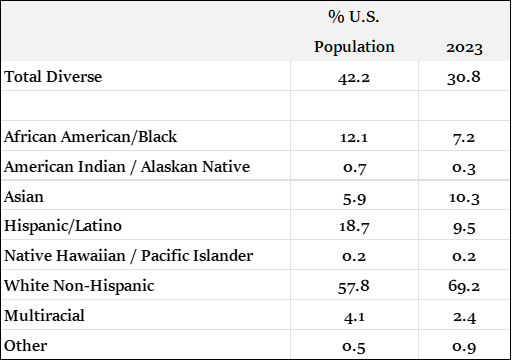For the sixth consecutive year, ANA is releasing "A Diversity Report for the Advertising/Marketing Industry." The study tracks the gender and ethnic diversity of ANA member companies and recommends steps to improve diversity.
Since its inception, this study has shown the strides the industry has made to increase gender and ethnic diversity. Year after year, we've been proud of the progress that's been made, while acknowledging our work was far from over.
Yet, this latest study has found that ethnic diversity took a step back, after several years of progress. The industry is now 30.8 percent ethnically diverse, down from 32.3 percent a year ago.

This past year was challenging for diversity. The U.S. Supreme Court struck down race-based affirmative action in higher education. There have been reports about the decline of chief diversity officer positions, including their outright elimination in some cases. The fears of an impending recession led some in Corporate America to reorganize, which translated to workforce reductions throughout many industries. Those reductions might have had the collateral damage of letting a disproportionate number of diverse marketers be a part of the downsizing. This all resulted in a step back for diversity in the advertising/marketing industry in 2023.
Yet there has been progress. There is encouraging news with gains in ethnic diversity at senior levels. There is 17.3 percent ethnic diversity in CMO positions, up from 14.6 percent, and the highest in the six-year study period. Furthermore, CMOs are 59.9 percent female, also the highest in the six-year study period.
Representation growth is an important initiative for the Society and Sustainability priority of the ANA Growth Agenda, which provides a guide for the industry to leverage marketing as a sustainable growth driver. A specific mandate for the Society and Sustainability working group is to achieve equal representation in the media and creative supply chain. This includes marketers, agencies, production crews, and media providers that create, distribute, and monetize advertising, programs, and content. This means that at every link in the chain, at every level, we aspire to achieve equal gender representation and ethnic representation equal to the U.S. population. For ethnicity, that means being as close to possible to the 42 percent diversity makeup of the U.S. population. Clearly, there is more work to do.
Equal representation is not just the right thing to do, it's the smart thing to do. With equal representation, the industry can see greater creativity and innovation as well as increased access to opportunity, which together lead to equity in income and wealth creation. That leads to purchasing power -- which leads to market growth.
"A Diversity Report for the Advertising/Marketing Industry" includes significant qualitative feedback to improve diversity. Best practices for talent recruitment include setting goals for the number of ethnically diverse hires to match the population of customers; having a diverse slate of candidates as well as diverse interview panels; and partnering with outside organizations that have a diversity perspective, such as HBCUs.
Retention is just as important as recruitment - and possibly even more so. Best practices for retention include senior leadership commitment to mentor and develop diverse employees; employee resource groups to help make diverse employees feel more connected; and continuously cultivating a culture of inclusion and belonging through consistent messaging about the importance and impact of DEI.
One step back and two steps forward. I am optimistic that 2024 will be a year where diversity in the advertising/marketing industry takes two steps (or more) forward.
Click the social buttons to share this story with colleagues and friends.
The opinions expressed here are the author's views and do not necessarily represent the views of




